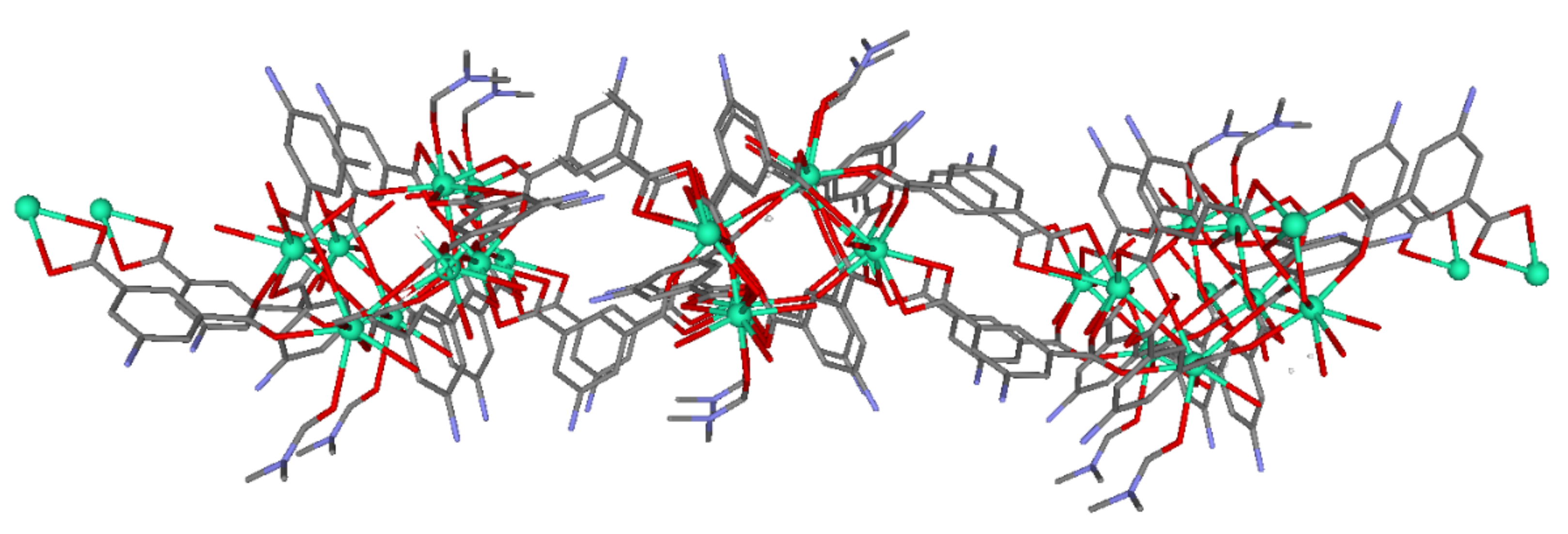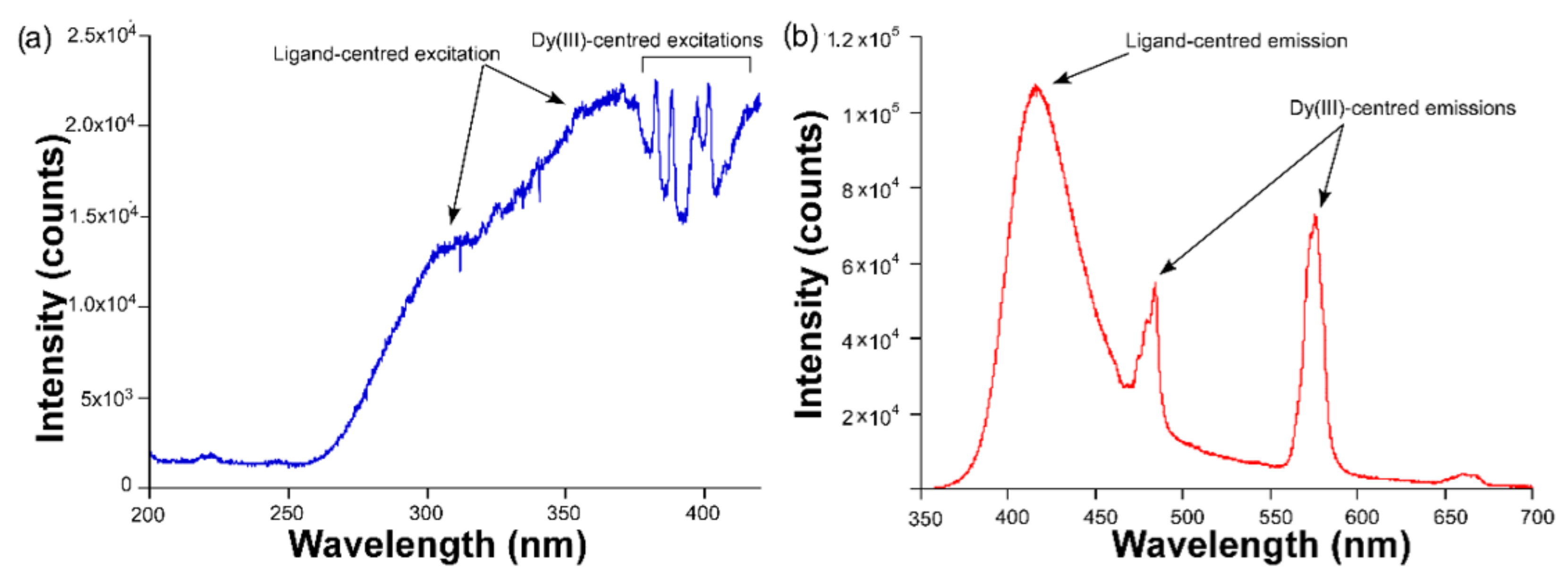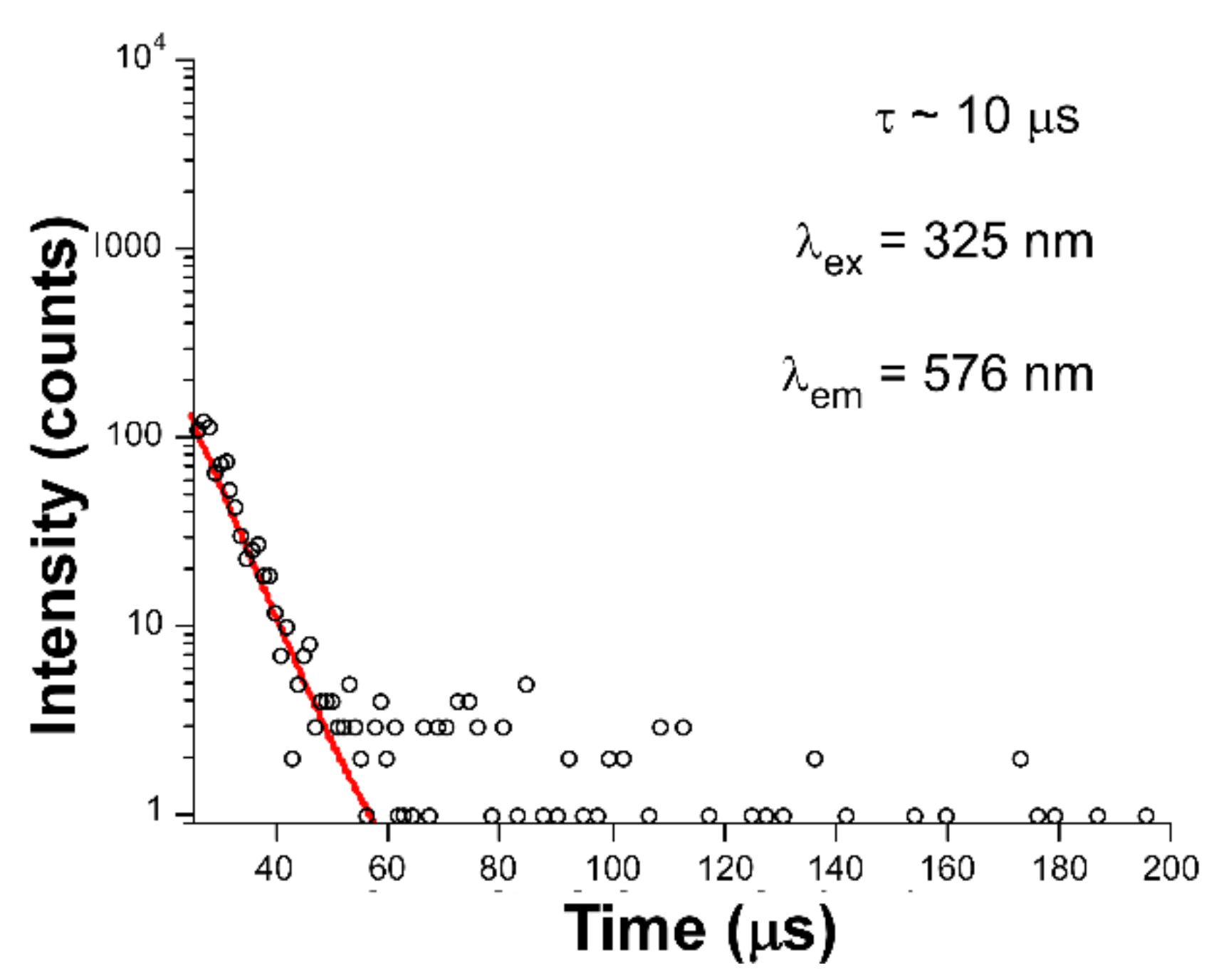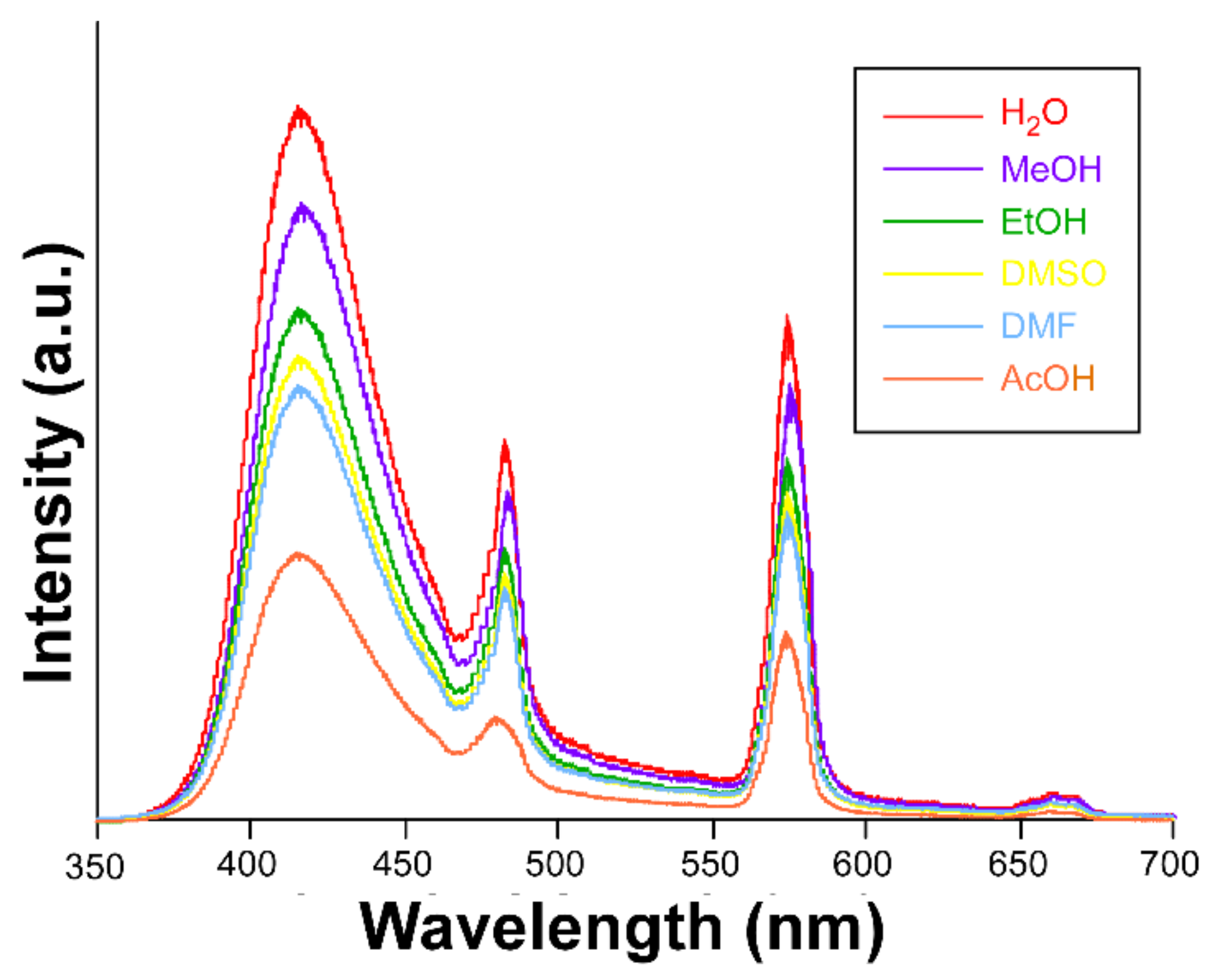Sensing Capacity in Dysprosium Metal–Organic Frameworks Based on 5-Aminoisophthalic Acid Ligand
Abstract
:1. Introduction
2. Materials and Methods
2.1. Chemicals
2.2. Synthesis of Compound 1
2.3. Synthesis of Compound 2
2.4. X-ray Diffraction Data Collection and Structure Determination
2.5. Photoluminescence Measurements
2.6. Preparation of the Test Paper
3. Results and Discussion
3.1. Description of the Structures
3.2. Luminescence Properties
3.3. Test Paper
4. Conclusions
Supplementary Materials
Author Contributions
Funding
Institutional Review Board Statement
Informed Consent Statement
Conflicts of Interest
References
- Peng, J.-M.; Wang, H.-L.; Zhu, Z.-H.; Liu, Z.-Y.; Zou, H.-H.; Liang, F.-P. Substituents lead to differences in the formation of a series of dysprosium hydrogen-bonded organic frameworks with high stability and acid stimulus-response luminescence properties. J. Mater. Chem. C 2021, 9, 9319–9330. [Google Scholar] [CrossRef]
- Qiu, S.; Zhu, G. Molecular engineering for synthesizing novel structures of metal-organic frameworks with multifunctional properties. Coord. Chem. Rev. 2009, 253, 2891–2911. [Google Scholar] [CrossRef]
- Cepeda, J.; Sebastian, E.S.; Padro, D.; Rodríguez-Diéguez, A.; Garcia, J.A.; Ugalde, J.M.; Seco, J.M. A Zn based coordination polymer exhibiting long-lasting phosphorescence. Chem. Commun. 2016, 52, 8671–8674. [Google Scholar] [CrossRef] [PubMed]
- Seco, J.M.; Fairen-Jimenez, D.; Calahorro, A.J.; Mendez-Linan, L.; Perez-Mendoza, M.; Casati, N.; Colacio, E.; Rodriguez-Dieguez, A. Modular structure of a robust microporous MOF based on Cu2 paddle-wheels with high CO2 selectivity. Chem. Commun. 2013, 49, 11329–11331. [Google Scholar] [CrossRef]
- Zheng, Y.; Sun, F.-Z.; Han, X.; Xu, J.; Bu, X.-H. Recent Progress in 2D Metal-Organic Frameworks for Optical Applications. Adv. Opt. Mater. 2020, 8, 2000110. [Google Scholar] [CrossRef]
- Calahorro, A.J.; Salinas-Castillo, A.; Seco, J.M.; Zuniga, J.; Colacio, E.; Rodriguez-Dieguez, A. Luminescence and magnetic properties of three metal-organic frameworks based on the 5-(1H-tetrazol-5-yl)isophthalic acid ligand. CrystEngComm 2013, 15, 7636–7639. [Google Scholar] [CrossRef]
- Garcıa-Garcıa, A.; Oyarzabal, I.; Cepeda, J.; Seco, J.M.; Garcia-Valdivia, A.A.; Gomez-Ruiz, S.; Salinas-Castillo, A.; Choquesillo-Lazarte, D.; Rodrıguez-Dieguez, A. Slow relaxation of magnetization and luminescence properties of a novel dysprosium and pyrene-1,3,6,8-tetrasulfonate based MOF. New J. Chem. 2018, 42, 832–837. [Google Scholar] [CrossRef]
- Oyarzabal, I.; Fernández, B.; Cepeda, J.; Gómez-Ruiz, S.; Calahorro, A.J.; Seco, J.M.; Rodríguez-Diéguez, A. Slow relaxation of magnetization in 3D-MOFs based on dysprosium dinuclear entities bridged by dicarboxylic linkers. CrystEngComm 2016, 18, 3055–3063. [Google Scholar] [CrossRef]
- Xu, W.-Q.; He, S.; Liu, S.-J.; Liu, X.-H.; Qiu, Y.-X.; Liu, W.-T.; Liu, X.-J.; Jiang, L.-C.; Jiang, J.-J. Post-synthetic modification of a metal-organic framework based on 5-aminoisophthalic acid for mercury sorption. Inorg. Chem. Commun 2019, 10, 107515. [Google Scholar] [CrossRef]
- Fu, L.M.; Wang, Y.N. Detection methods and applications of microfluidic paper-based analytical devices. TrAC Trends Anal. Chem. 2018, 107, 196–211. [Google Scholar] [CrossRef]
- Dincer, C.; Bruch, R.; Costa-Rama, E.; Fernández-Abedul, M.T.; Merkoçi, A.; Manz, A.; Urban, G.A.; Güder, F. Disposable Sensors in Diagnostics, Food, and Environmental Monitoring. Adv. Mater. 2019, 31, 1806739. [Google Scholar] [CrossRef]
- David, M.C.; Jaclyn, A.; Mettakoonpitak, J.; Charles, S.H. Recent Developments in Paper-Based Microfluidic Devices. Anal. Chem. 2015, 87, 19–41. [Google Scholar] [CrossRef]
- Ortiz-Gómez, I.; Salinas-Castillo, A.; García, A.G.; Álvarez-Bermejo, J.A.; de Orbe-Payá, I.; Rodríguez-Diéguez, A.; Capitán-Vallvey, L.F. Microfluidic paper-based device for colorimetric determination of glucose based on a metal-organic framework acting as peroxidase mimetic. Microchim. Acta 2018, 185, 47. [Google Scholar] [CrossRef]
- Bruker Apex2; Bruker AXS Inc.: Madison, WI, USA, 2004.
- Sheldrick, G.M. SADABS, Program for Empirical Adsorption Correction; Institute for Inorganic Chemistry, University of Gottingen: Gottingen, Germany, 1996. [Google Scholar]
- Altomare, A.; Burla, M.C.; Camilla, M.; Cascarano, G.L.; Giacovazzo, C.; Guagliardi, A.; Moliterni, A.G.G.; Polidori, G.; Spagna, R.J. SIR97: A new tool for crystal structure determination and refinement. Appl. Cryst. 1999, 32, 115–119. [Google Scholar] [CrossRef]
- Sheldrick, G.M. SHELX-2014, Program for Crystal Structure Refinement; University of Göttingen: Göttingen, Germany, 2014. [Google Scholar]
- Farrugia, L.F. WinGX suite for small-molecule single-crystal cystallography. J. Appl. Cryst. 1999, 32, 837–838. [Google Scholar] [CrossRef]
- Singh, M.P.; Tarai, A.; Baruah, J.B. Neutral, Zwitterion, Ionic Forms of 5-Aminoisophthalic Acid in Cocrystals, Salts and Their Optical Properties. Chem. Eur. 2019, 4, 5427–5436. [Google Scholar] [CrossRef]
- Yang, Y.; Wang, K.-Z.; Yan, D. Ultralong Persistent Room Temperature Phosphorescence of Metal Coordination Polymers Exhibiting Reversible pH-Responsive Emission. ACS Appl. Mater. Interfaces 2016, 8, 15489–15496. [Google Scholar] [CrossRef]
- Yang, X.; Yan, D. Long-lasting phosphorescence with a tunable color in a Mn2+-doped anionic metal–organic framework. J. Mater. Chem. C 2017, 5, 7898–7903. [Google Scholar] [CrossRef]
- Oyarzabal, I.; Rodríguez-Diéguez, A.; Barquín, M.; Seco, J.M.; Colacio, E. The effect of the disposition of coordinated oxygen atoms on the magnitude of the energy barrier for magnetization reversal in a family of linear trinuclear Zn–Dy–Zn complexes with a square-antiprism DyO 8 coordination sphere. Dalton Trans. 2017, 46, 4278–4286. [Google Scholar] [CrossRef]
- Gai, Y.L.; Xiong, K.-C.; Chen, L.; Bu, Y.; Li, X.-J.; Jiang, F.-L.; Hong, M.-C. Visible and NIR Photoluminescence Properties of a Series of Novel Lanthanide–Organic Coordination Polymers Based on Hydroxyquinoline–Carboxylate Ligands. Inorg. Chem. 2012, 51, 13128–13137. [Google Scholar] [CrossRef]
- Wu, M.-F.; Wang, M.-S.; Guo, S.-P.; Zheng, F.-K.; Chen, H.-F.; Jiang, X.-M.; Liu, G.-N.; Guo, G.-C.; Huang, J.-S. Photoluminescent and Magnetic Properties of a Series of Lanthanide Coordination Polymers with 1H-Tetrazolate-5-formic Acid. Cryst. Growth Des. 2011, 11, 372–381. [Google Scholar] [CrossRef]
- Quici, S.; Cavazzini, M.; Marzanni, G.; Accorsi, G.; Armaroli, N.; Ventura, B.; Barigelletti, F. Visible and Near-Infrared Intense Luminescence from Water-Soluble Lanthanide [Tb(III), Eu(III), Sm(III), Dy(III), Pr(III), Ho(III), Yb(III), Nd(III), Er(III)] Complexes. Inorg. Chem. 2005, 44, 529–537. [Google Scholar] [CrossRef] [PubMed]
- Beeby, A.; Clarkson, I.M.; Dickins, R.S.; Faulkner, S.; Parker, D.; Royle, L.; de Sousa, A.S.; Gareth Williams, J.A.; Woods, M. Non-radiative deactivation of the excited states of europium, terbium and ytterbium complexes by proximate energy-matched OH, NH and CH oscillators: An improved luminescence method for establishing solution hydration states. J. Chem. Soc. Perkin Trans. 1999, 3, 493–504. [Google Scholar] [CrossRef]
- Cepeda, J.; Beobide, G.; Castillo, O.; Luque, A.; Pérez-Yáñez, S. Structural diversity of coordination compounds derived from double-chelating and planar diazinedicarboxylate ligands. Coord. Chem. Rev. 2017, 352, 83–107. [Google Scholar] [CrossRef]
- Pajuelo-Corral, O.; Rodríguez-Diéguez, A.; Beobide, G.; Pérez-Yáñez, S.; García, J.A.; San Sebastian, E.; Seco, J.M.; Cepeda, J. Alkaline-earth and aminonicotinate based coordination polymers with combined fluorescence/long-lasting phosphorescence and metal ion sensing response. J. Mater. Chem. C 2019, 7, 6997–7012. [Google Scholar] [CrossRef]
- Melavanki, R.M.; Kusanur, R.A.; Dadadevaramath, J.S.; Kulkarni, M.V.J. Effect of solvent polarity on the fluorescence quenching of biologically active 5BAMC by aniline in binary solvent mixtures. Fluorescence 2010, 20, 1175–1180. [Google Scholar] [CrossRef]







| Compound 1 | Compound 2 | |
|---|---|---|
| CCDC | 2103354 | 2103353 |
| Formula | C57H75Dy4N9O39 | C54H70Dy4N8O39 |
| M | 2160.26 | 2105.18 |
| Crystal System | Triclinic | Triclinic |
| Space group | P-1 | P-1 |
| T (K) | 100 | 100 |
| a (Å) | 12.0914 (16) | 13.5278 (7) |
| b (Å) | 13.4186 (17) | 14.2508 (8) |
| c (Å) | 24.493 (3) | 19.8040 (10) |
| α (deg) | 76.929 (4) | 77.679 (2) |
| β (deg) | 85.627 (4) | 70.471 (2) |
| γ (deg) | 87.332 (5) | 83.739 (2) |
| V (Å3) | 3858.0 (8) | 3512.4 (3) |
| Z | 2 | 2 |
| Density (g cm−3) | 1.86 | 1.991 |
| μ (mm−1) | 3.927 | 4.31 |
| Observed reflections | 10617 | 56588 |
| Rint | 0.092 | 0.0435 |
| R1 b/wR2 c (I > 2σ(I)) | 0.0553/0.1279 | 0.0260/0.0513 |
| R1 b/wR2 c (all data) | 0.0783/0.1409 | 0.0366/0.0544 |
| GoF (S) a | 1.029 | 1.048 |
| Largest diff. pk and hole (eÅ−3) | 3.355 and −3.289 | 0.872 and −0.555 |
Publisher’s Note: MDPI stays neutral with regard to jurisdictional claims in published maps and institutional affiliations. |
© 2022 by the authors. Licensee MDPI, Basel, Switzerland. This article is an open access article distributed under the terms and conditions of the Creative Commons Attribution (CC BY) license (https://creativecommons.org/licenses/by/4.0/).
Share and Cite
Cepeda, J.; Blasco-Pascual, I.; Rojas, S.; Choquesillo-Lazarte, D.; Guerrero-Arroyo, F.J.; Morales, D.P.; García, J.Á.; Rodríguez-Diéguez, A.; Salinas-Castillo, A. Sensing Capacity in Dysprosium Metal–Organic Frameworks Based on 5-Aminoisophthalic Acid Ligand. Sensors 2022, 22, 3392. https://doi.org/10.3390/s22093392
Cepeda J, Blasco-Pascual I, Rojas S, Choquesillo-Lazarte D, Guerrero-Arroyo FJ, Morales DP, García JÁ, Rodríguez-Diéguez A, Salinas-Castillo A. Sensing Capacity in Dysprosium Metal–Organic Frameworks Based on 5-Aminoisophthalic Acid Ligand. Sensors. 2022; 22(9):3392. https://doi.org/10.3390/s22093392
Chicago/Turabian StyleCepeda, Javier, Isabel Blasco-Pascual, Sara Rojas, Duane Choquesillo-Lazarte, Francisco J. Guerrero-Arroyo, Diego P. Morales, Jose Ángel García, Antonio Rodríguez-Diéguez, and Alfonso Salinas-Castillo. 2022. "Sensing Capacity in Dysprosium Metal–Organic Frameworks Based on 5-Aminoisophthalic Acid Ligand" Sensors 22, no. 9: 3392. https://doi.org/10.3390/s22093392
APA StyleCepeda, J., Blasco-Pascual, I., Rojas, S., Choquesillo-Lazarte, D., Guerrero-Arroyo, F. J., Morales, D. P., García, J. Á., Rodríguez-Diéguez, A., & Salinas-Castillo, A. (2022). Sensing Capacity in Dysprosium Metal–Organic Frameworks Based on 5-Aminoisophthalic Acid Ligand. Sensors, 22(9), 3392. https://doi.org/10.3390/s22093392











